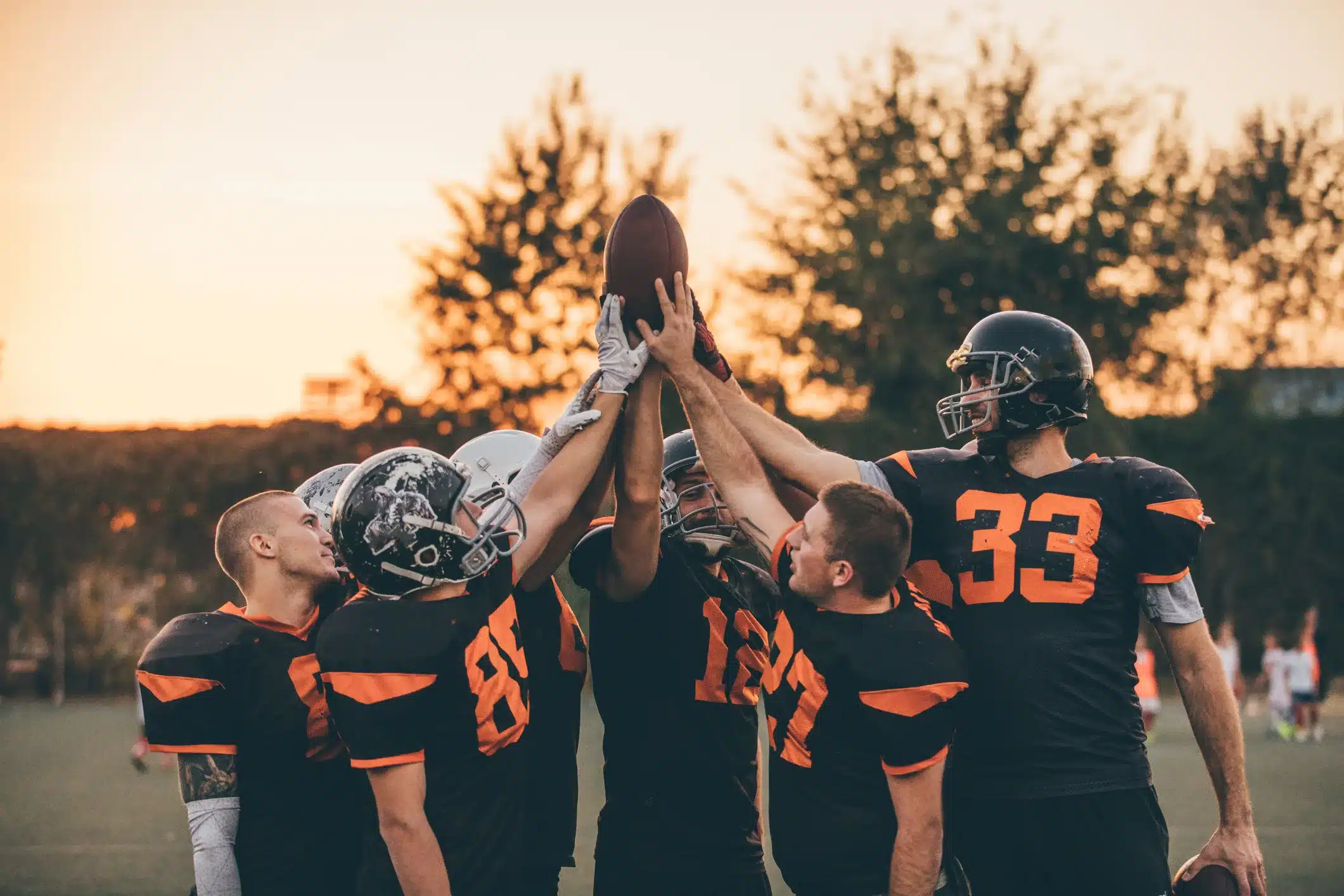
Some of our favorite sports return in the fall, but so do the risks of fall sports injuries. We’re talking about the most common sports injuries in the fall and how to prevent them from sidelining you.
As the sweltering summer heat gives way to the cooler temperatures of fall, many of us are grateful we can finally walk to the mailbox without becoming a sweaty mess! We also cherish the beautiful changing leaves, delicious pumpkin spice lattes, and our favorite fall sports!
Common Fall Sports
Fall ushers in the return of many much-loved sports, such as:
- Cross Country Running
- Cheerleading
- Field Hockey
- Football
- Golf
- Lacrosse
- Soccer
- Tennis
- Volleyball
Playing sports has many benefits, such as improved confidence, discipline, emotional well-being, mood, and physical fitness. However, there is a risk of injury when you play sports.
Fall Sports Injuries
Some of the most common fall sports injuries include concussions, dislocations, fractures, patellofemoral syndrome, shin splints, and sprains and strains. Let’s take a closer look at each of these injuries and the activities that can cause them.
Concussions
Concussion is the term used to describe the signs and symptoms a person may experience after a mild traumatic brain injury (TBI). These injuries are more common in contact sports like football and soccer, in which a player’s head may collide with a ball or another player.
An estimated ten percent of the 2.5 million cases of TBIs in the United States every year are caused by sports injuries. The risk for concussion in athletes who play contact sports is as high as 20 percent per season.
Concussion signs and symptoms may include:
- Confusion
- Dizziness
- Ear Ringing
- Headache
- Loss of consciousness
- Memory deficits
- Nausea or vomiting
- Sensitivity to light or sound
- Slurred or incoherent speech
If you experience a concussion, you should be evaluated by a medical professional before you continue to play your sport. Multiple concussions without proper recovery can lead to long-term complications.
Dislocations
When two bones that form a joint are forced out of position, your joint is dislocated. Dislocations are more likely in contact sports such as cheerleading, field hockey, and football.
The most common joints dislocated in sports are fingers, kneecaps, and shoulders. This painful injury requires medical attention to reduce (put back in place) the joint. Your healthcare provider may recommend physical therapy to rehabilitate and strengthen your joint to prevent further dislocations. Once a joint becomes dislocated, it is more likely to dislocate again.
Fractures
Many types of broken bones exist, such as displaced or nondisplaced and closed or open fractures. A fracture is usually the result of a high-impact strike or trauma in a contact sport such as cheerleading, field hockey, football, lacrosse, and soccer. Falls frequently cause fractures and may occur in any fall sport.
The most common bones fractured in fall sports are the ankle, collarbone, forearm, and wrist. Fractures require medical attention to heal correctly.
Patellofemoral Syndrome
A painful knee injury caused by irritation of the cartilage in the knee is called patellofemoral syndrome. It is also referred to as a runner’s knee because it occurs frequently in runners.
If you develop patellofemoral syndrome, you can treat it at home using the PRICE protocol (protection, rest, ice, compression, and elevation) and over-the-counter anti-inflammatory pain medications like ibuprofen.
If home treatment does not improve your pain, your healthcare provider may refer you to a sports medicine provider or a physical therapist. They can help you rehabilitate and strengthen your core, knee, and surrounding muscle groups.
Shin Splints
Runners are the athletes who most commonly suffer from shin splints. Shin splints are pain felt along the shinbone in the tissue that holds the muscle to the bone.
Shin splints are often overuse injuries caused by increasing training too quickly and training too frequently without adequate rest periods. Shin splints may also be caused by running on hard surfaces and wearing shoes without proper support.
Sprains and Strains
Sprains and strains are often used interchangeably, but there is a difference between the two injuries.
You can incur a sprain when you overstretch, tear, or twist a ligament. Ligaments are connective tissues that connect your bones to other bones or cartilage.
One of the most common knee injuries, an anterior cruciate ligament (ACL) tear, is an example of a sprain. Ankles are the most common joints sprained. Sprains may occur in any sport and are often a result of a sudden pivoting or twisting motion.
You can incur a strain when you overstretch, tear, or twist a tendon or a muscle. Tendons are bands of tissue that connect your muscles to your bones.
One of the most common shoulder injuries, a rotator cuff tear, is an example of a strain. Groin pulls, strains in the muscles of the inner thighs, are a fall sports injury seen in sports that require sudden side-to-side movements such as tennis. Tennis elbow and golfer’s elbow are overuse strain injuries of the tendons in the elbow.
Symptoms of sprains and strains include bruising, pain, and swelling. Most sprains and strains can be treated at home using the PRICE protocol (protection, rest, ice, compression, and elevation) and over-the-counter anti-inflammatory pain medications.
Preventing Fall Sports Injuries
First thing first – if you have a student-athlete playing fall sports, it is essential they have a sports physical before their season begins. A sports physical can help identify any health conditions or previous injuries that can be addressed to maximize their safe participation in sports.
Likewise, if you play sports at the adult level, we recommend an annual physical exam. A yearly physical can help uncover pre-existing injuries that may need rehabilitation before your favorite fall sport worsens the injury.
Additional tips for preventing fall sports injuries include:
- Always stretch and warm up before engaging in your fall sport to prevent muscle and tendon strains.
- Diversify your training to use and strengthen all your muscle groups to prevent overuse injuries.
- Ease back into your fall sport. Build up your training and playing time slowly.
- Fuel your body with a nutritious diet and plenty of fluids to maintain peak performance.
- Listen to your body if you are having pain – don’t try to play through the pain. A little rest and recovery could save you from a more significant injury.
- Play by the rules. Always practice proper technique in your sport, such as jumping, landing, pivoting, swinging, and tackling, to prevent concussions, strains, and sprains.
- Schedule rest time to allow your body to recover and prevent overuse injuries.
- Wear the appropriate equipment for your fall sport, such as football pads to prevent collarbone fractures, a helmet to prevent concussions, and supportive shoes to prevent shin splints.
Turn to MainStreet Family Care
Do you or your child have an injury from your favorite fall sport? Or do you need a sports physical or annual exam before you hit the track or field? MainStreet Urgent Care Services can help!
Register online to visit one of our clinics near you today. You can wait in the convenience of your home or car until we’re ready to see you. We’ll text you when it’s time to head to the clinic.
We also accept walk-ins! However, please be aware that walk-ins join the same queue as those who register online and may experience longer in-clinic wait times.






